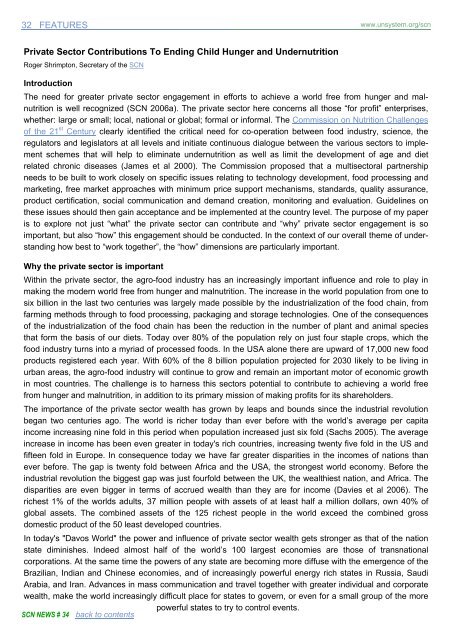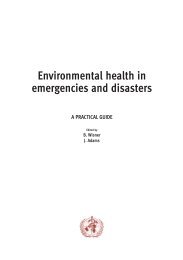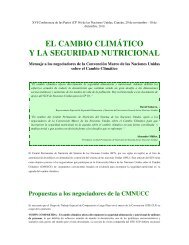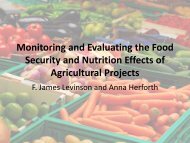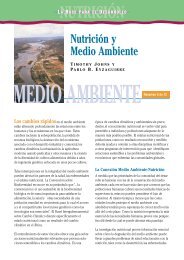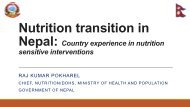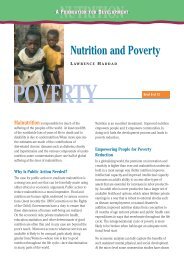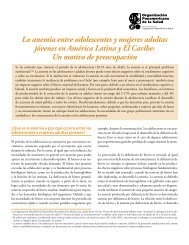SCN News No 34 - UNSCN
SCN News No 34 - UNSCN
SCN News No 34 - UNSCN
You also want an ePaper? Increase the reach of your titles
YUMPU automatically turns print PDFs into web optimized ePapers that Google loves.
32 FEATURES<br />
www.unsystem.org/scn<br />
Private Sector Contributions To Ending Child Hunger and Undernutrition<br />
Roger Shrimpton, Secretary of the <strong>SCN</strong><br />
Introduction<br />
The need for greater private sector engagement in efforts to achieve a world free from hunger and malnutrition<br />
is well recognized (<strong>SCN</strong> 2006a). The private sector here concerns all those “for profit” enterprises,<br />
whether: large or small; local, national or global; formal or informal. The Commission on Nutrition Challenges<br />
of the 21 st Century clearly identified the critical need for co-operation between food industry, science, the<br />
regulators and legislators at all levels and initiate continuous dialogue between the various sectors to implement<br />
schemes that will help to eliminate undernutrition as well as limit the development of age and diet<br />
related chronic diseases (James et al 2000). The Commission proposed that a multisectoral partnership<br />
needs to be built to work closely on specific issues relating to technology development, food processing and<br />
marketing, free market approaches with minimum price support mechanisms, standards, quality assurance,<br />
product certification, social communication and demand creation, monitoring and evaluation. Guidelines on<br />
these issues should then gain acceptance and be implemented at the country level. The purpose of my paper<br />
is to explore not just “what” the private sector can contribute and “why” private sector engagement is so<br />
important, but also “how” this engagement should be conducted. In the context of our overall theme of understanding<br />
how best to “work together”, the “how” dimensions are particularly important.<br />
Why the private sector is important<br />
Within the private sector, the agro-food industry has an increasingly important influence and role to play in<br />
making the modern world free from hunger and malnutrition. The increase in the world population from one to<br />
six billion in the last two centuries was largely made possible by the industrialization of the food chain, from<br />
farming methods through to food processing, packaging and storage technologies. One of the consequences<br />
of the industrialization of the food chain has been the reduction in the number of plant and animal species<br />
that form the basis of our diets. Today over 80% of the population rely on just four staple crops, which the<br />
food industry turns into a myriad of processed foods. In the USA alone there are upward of 17,000 new food<br />
products registered each year. With 60% of the 8 billion population projected for 2030 likely to be living in<br />
urban areas, the agro-food industry will continue to grow and remain an important motor of economic growth<br />
in most countries. The challenge is to harness this sectors potential to contribute to achieving a world free<br />
from hunger and malnutrition, in addition to its primary mission of making profits for its shareholders.<br />
The importance of the private sector wealth has grown by leaps and bounds since the industrial revolution<br />
began two centuries ago. The world is richer today than ever before with the world’s average per capita<br />
income increasing nine fold in this period when population increased just six fold (Sachs 2005). The average<br />
increase in income has been even greater in today's rich countries, increasing twenty five fold in the US and<br />
fifteen fold in Europe. In consequence today we have far greater disparities in the incomes of nations than<br />
ever before. The gap is twenty fold between Africa and the USA, the strongest world economy. Before the<br />
industrial revolution the biggest gap was just fourfold between the UK, the wealthiest nation, and Africa. The<br />
disparities are even bigger in terms of accrued wealth than they are for income (Davies et al 2006). The<br />
richest 1% of the worlds adults, 37 million people with assets of at least half a million dollars, own 40% of<br />
global assets. The combined assets of the 125 richest people in the world exceed the combined gross<br />
domestic product of the 50 least developed countries.<br />
In today's "Davos World" the power and influence of private sector wealth gets stronger as that of the nation<br />
state diminishes. Indeed almost half of the world’s 100 largest economies are those of transnational<br />
corporations. At the same time the powers of any state are becoming more diffuse with the emergence of the<br />
Brazilian, Indian and Chinese economies, and of increasingly powerful energy rich states in Russia, Saudi<br />
Arabia, and Iran. Advances in mass communication and travel together with greater individual and corporate<br />
wealth, make the world increasingly difficult place for states to govern, or even for a small group of the more<br />
powerful states to try to control events.<br />
<strong>SCN</strong> NEWS # <strong>34</strong> back to contents


